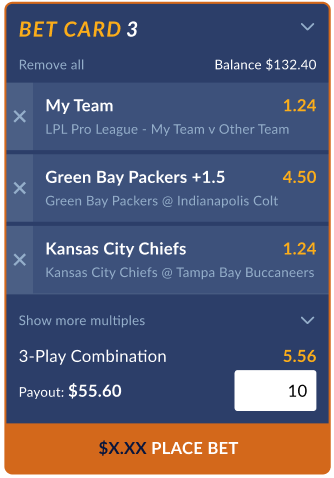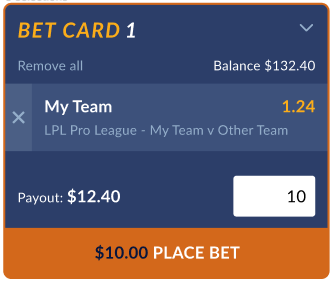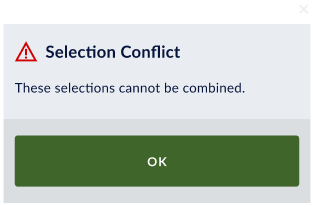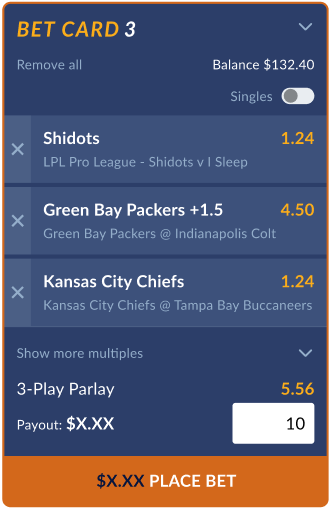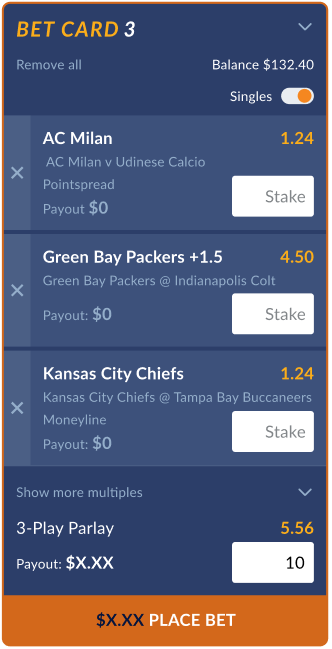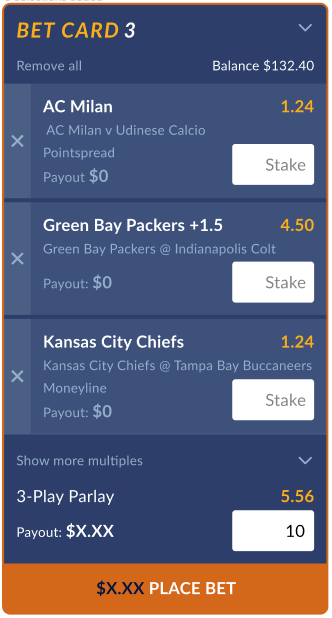Multiple Singles(Designing with Data)
In-short
This article discusses the process I used at Avid Gaming to create a better betting product for Sports Interaction, beginning by looking at user behaviour data, creating a hypothesis of what might work based on learned usability factors and executing it for the Sports Interaction betting product. The work focused on allowing betting customers to place multiple single bets in a single submission rather than having to submit them separately. The challenge was to make the product improvement work for both the customer and the business.
Sports Interaction – The Background
Sports Interaction is an online betting application. The target audience is very specifically recreational Canadian Bettors. Recreational means that betting is not a major part of their lives and they won’t tolerate having to invest great effort for the joy of using it. Canadian means these customers are crazy about sport and want to add a bit of extra enjoyment to it. Betting is not the end goal but rather an enhancement to an already established pastime. What we were working with was a low tolerance of friction, high expectation of fun. The market is highly competitive. If we don’t get it right for these customers, someone else certainly will.
The Bet Card – the Crucial Interaction
The bet card is the part of the application where customers add the selections of what they want to bet on and then make choices about what bets they then want to place using these selections. They can see their potential bet outcomes. In Canada there is a culture of placing combination bets. This means that a person suggests two different outcomes and both of these must be true for the bet to win. These are fun bets for the customer because they yield big rewards if successful. These are also very profitable for the business because the more selections added to a combination bet the smaller the chance of winning.
A more straightforward type of bet is a single bet. This one does what it says on the tin. It is a single event that, if true the bet wins. Easy for the customer but the winnings are pretty conservative. Not great for the business because the likelihood of winning is much greater than for a combination bet.
Here we come back to the type of customer we’re targeting – this bet is EASY for the customer. This customer type needs the job-at-hand to be easy.
Asking the Right Questions
Knowing that placing a single bet was easy, but also knowing that combination bets were more profitable for the business, I wanted to determine what was the right thing to do to serve both parties. Here are the questions I asked:
Are customers placing a lot of single bets?
How frequently are people placing single bets?
What errors are customers encountering on the bet card? What can these tell us?
What is the time between one single bet and the next? Are there clusters?
How frequently are customers removing selections from the bet card? (indicating change of mind or error)
How difficult is it for a person to place multiple single bets?
Observation
Using a combination of Google Analytics, Hotjar observation and customer betting records, I was able to determine a few valuable things.
If a person added selections to the betcard and these selections could not be combined then an error message would show telling them that. This was ten times the most common error message shown for Sports Interaction. A big red light! I read that as a green light for change.
But why would a person do that? There are a few reasons. Either they didn’t know these outcomes couldn’t be combined, or they thought they could place multiple single bets at once. The customer was telling us what they wanted by their actions.
Given this information I then wondered if customers were working around the capability of the application and placing multiple single bets one-by-one on the bet card. For this we looked at clusters of single bets by an individual within a short timeframe. This was indeed a common pattern. Again – a strong pointer for change. Customers were having to add a selection, enter stake, place bet then repeat the whole process for the next bet. The effort was taking from the fun.
Proposed Solution
I proposed that we upgrade the Sports Interaction betcard so that a customer could add selections and then decide to place a combination bet or a set of single bets or better still – both in a single submission. There would be a small amount of learning for the customer but it could eliminate a lot of error messages and ultimately give the customer what they were looking for in our product. This involved a big risk that I will delve into further.
Balancing Usability, Customer Relationships and Revenue.
Knowing that the customer had a desire for multiple single bets it was clear that I needed to change the bet card to accommodate this. There were other factors at play, however. First, single bets were far less profitable for the business, and I met with fierce resistance from business owners trying to meet targets for the year. Second – we learned from forum observations and from customer service feedback that combination bets were more engaging. They took longer on average to settle, meaning a stronger engagement between customer and brand.
My challenge was to balance what the user wanted and what the business needed.
I put forward a list of hypotheses. Here are some:
Spend
We will make similar profit
Customers will spend more overall on placing bets
Betting behaviour
More singles will be placed and fewer full parlays.
Users will recycle singles wins.
More smaller combinations will be placed. (sub-sets of the total set of selections)
More bets overall will be placed.
Quality of UX
They will be far less likely to remove a selection from the betcard
There will be more bets placed for fewer betcard submissions
They will be far less likely to see the ‘bet conflict’ error.
Will spend less time completing their betting tasks.
Longer term
This group will stay active with us for longer.
Users will be more likely to recommend to a friend.
Overall better brand experience.
General
We will have more calls from this group to CS about the betcard initially but fewer after a period of 2 months than the before time.
The Big-Bang, Big-Risk Design
If we were big-bang risk takers what we would do is to immediately offer the functionality that customers were showing a desire for. It would look something like this:
All customers would be shown a bet card on which they could place single bets and combination bets all at once. We were not big risk takers but we did embrace a challenge.
The customer may be happy but the business could suffer.
Measured Risk
I knew that giving the customer what they wanted would keep them with us longer. We may end up making a little less revenue from them per month but there would be a lot more months so overall a far better outcome. Testing this would have to happen over a long stretch of time.
At Avid Gaming we had established a strong culture of understanding that our business would only grow if we built strong, lasting relationships with customers, but taking a risk was hard.
Step one was to propose measured risk-taking. A small risk was a lot more palatable to business owners than a big leap. Now the challenge was to design something that didn’t upset the status-quo too much, but that effectively proved my hypothesis. We would do something small to test the waters then we would move forward or roll back. As was common practice, the new feature would be presented to a test group of 10% with the control being the existing version.
The design challenge was to do the least thing to learn the most.
The MVP – The Least Thing to Learn the Most
We would default to the status-quo with one small exception. We would add a toggle switch to the top of the betcard that would allow a person to switch on the ability to place multiple singles. We would show this to 10% of our users. If a customer switched this on then we would remember that choice for the next visit. It looked like the below:
We made some realistic prototypes for this. This was quicker than wireframing in this case because we had an already established library of interface elements from which to draw on. We tested these with the objective of just seeing if a person would notice the toggle switch. For this we used some willing customer participants and some colleagues in Canada. 80% of people noticed the toggle – enough for us to think it would do its job well enough.
What we learned
We tested for two months. The criteria for success were pretty broad. If a customer had multiple singles switched on then we knew they wanted the functionality. If they placed singles and multiple singles at once then the functionality was useful to them. If we overall made as much revenue from them then this could be deemed a success.
When the results came in they were nicely surprising. Surprise teaches us never to fully trust our instinct or gut feelings. In this case the surprise didn’t necessarily tell us we were wrong but that there were aspects of this feature we hadn’t fully expected. While we thought people would place more singles, we didn’t count on them recycling their wins so swiftly. Single bets pay out on average quicker than combination bets. Theres only one result to wait for rather than a set of results. This means that wins on singles can be placed again on another bet. On paper, combination bets were most profitable, in reality, allowing singles meant more bets were placed overall. The test group were the more profitable group than the control group!
It was a good day for customer-centric product development.
What happened next.
Now we knew that customers placing multiple singles was a good idea it was time to really encourage it. To date, the default state of the bet card was to hide multiple singles. We would now switch the default state to nudge more people in this good direction.
A standard user would see multiples open by default. They would not encounter error messages for related selections because the conflict was no longer there. They would place bets faster and most importantly enjoy a strong, longer-lasting relationship with our product and by extension our brand.
Conclusion
We took a small risk and learned from it. It was a success and we built on it. If it wasn’t then we would have learned a lot about our customers anyway. This one was a win-win.
